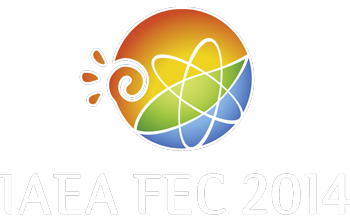Speaker
Mr
Dylan P. Brennan
(USA)
Description
Recent simulation results have indicated that in experiments with weakly reversed magnetic shear and the minimum in safety factor q just above unity, energetic particles in a slowing down distribution can drive two important MHD modes unstable, one a non-resonant, dominantly 1/1 mode localized within the minimum in q, and the other a resonant, dominantly 2/1 mode, which can cause a disruption of the discharge. These discharges tend to have a long steady state with high confinement, and are therefore a candidate operational scenario for burning plasma experiments. The delta-f kinetic-MHD model in the 3-D extended MHD code NIMROD is used to perform a simulation study of energetic particle effects on these two instabilities. The analysis makes use of model equilibria relevant to the DIII-D and NSTX experiments, where related instabilities are observed.
Experimentally, during steady state operation, a benign nonlinearly saturated m/n=1/1 structure is observed, in qualitative agreement with the computed mode in key physical respects. At slightly higher beta-N the 2/1 mode is found unstable and terminates the discharge. To explain the physics of the driven instabilities we examine their theoretical origins in simplified configurations, including an analysis of the mode-particle resonances.
We use the Orbit code to analyze these resonances between the particles and the mode, in both the ideal MHD stable and particle driven cases. Ideal MHD eigenfunctions have a fixed phase of the instability with radius, which is the usual basis on which to study mode-particle interaction, while the non-ideal MHD eigenfunctions with particle interaction effects can have phase variation in the radial direction. The Orbit code has thus been modified to account for this phase variation. The details of the resonant interaction in the simulations is clarified by this analysis, in that the perturbations generate islands in the phase space of particle orbits, the structure of which sheds light on the physics of the interaction.
| Country or International Organisation | USA |
|---|---|
| Paper Number | TH/P7-1 |
Author
Mr
Dylan P. Brennan
(USA)
Co-authors
A. D. Turnbull
(General Atomics)
J. M. Finn
(Los Alamos National Laboratory)
M. R. Halfmoon
(University of Tulsa)
R. White
(Princeton Plasma Physics Laboratory)

